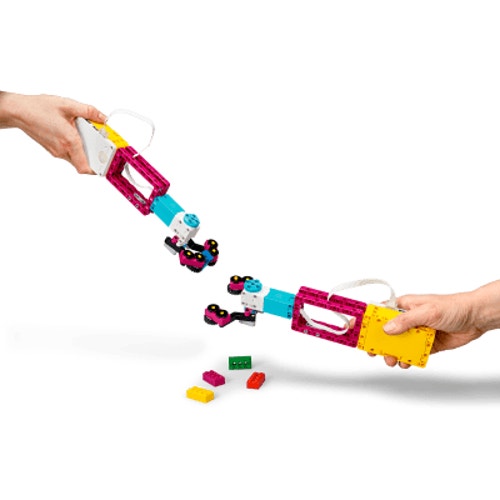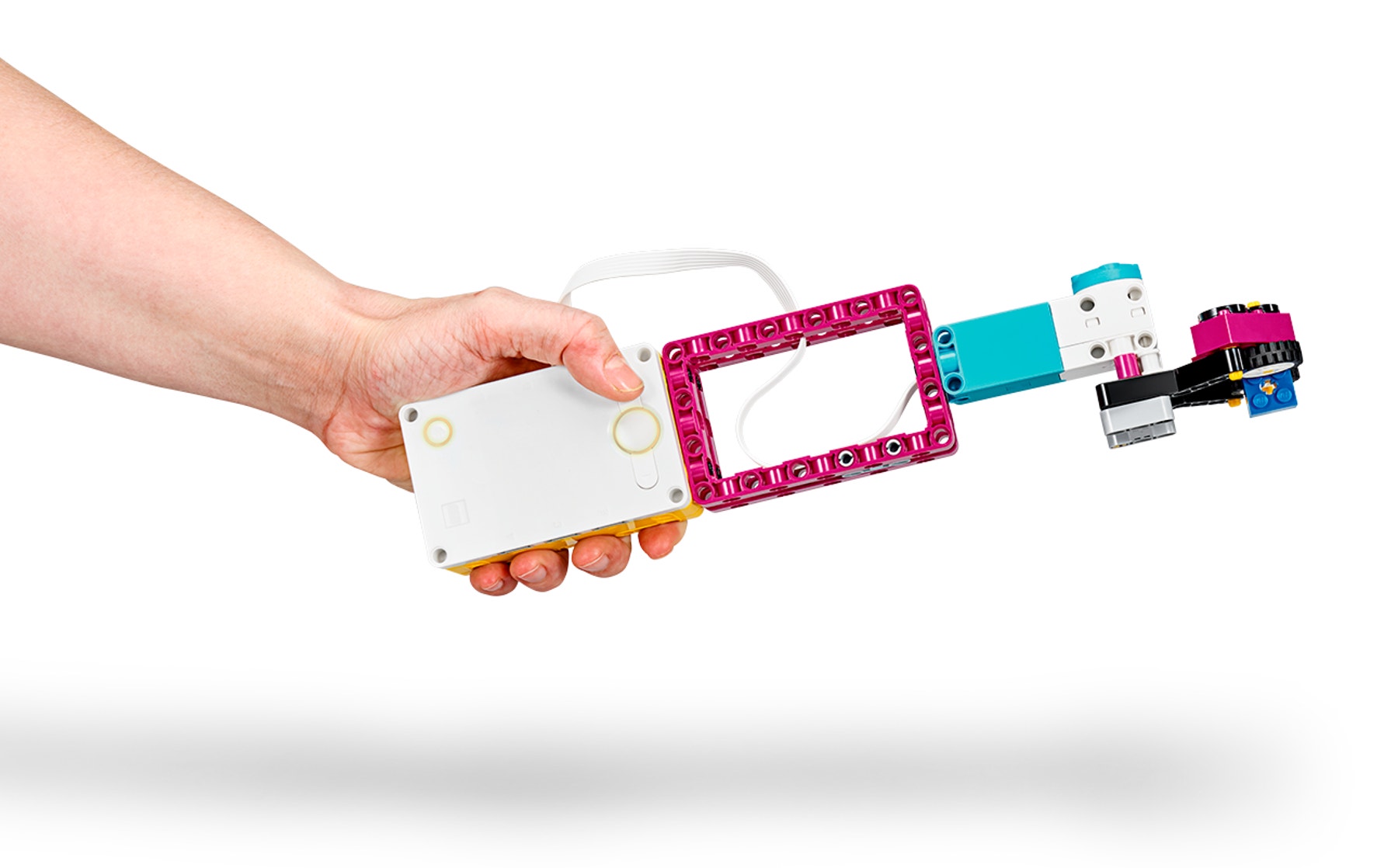Pass the Brick
Practice teamwork techniques by working through four engaging challenges.

Lesson Plan
1. Prepare
- Read through the student material in the LEGO® Education SPIKE™ App.
- If you feel it's needed, plan a lesson using the getting started material in the app. This will help familiarize your students with LEGO® Education SPIKE™ Prime.
2. Engage (5 Min.)
- Use the ideas in the Ignite a Discussion section below to engage your students in a discussion related to this lesson.
- Use the video to explain the lesson.
3. Explore (10 Min.)
- Split your class into an even number of teams with 2-3 students per team.
- Ask each team to pick a leader.
- Give the teams 5 minutes to build the Robotic Hand and six LEGO bricks used for points.
- Tell them to work as quickly as possible. (The focus here is on all team members aiming for a common goal.)
- Have the teams test their models to make sure they work.
4. Explain (15 Min.)
- Have each team pick a new leader for Challenge #2.
- Tell your students to take turns using their Robotic Hand to move one brick at a time from point A to point B. (This is another example of teamwork focusing on everyone aiming for a common goal.)
- Now it's time for Challenge #3 and new team leaders!
- The team members have 3 minutes to take turns stacking one brick on top of another.
- How high can they go?
- If the tower falls, the person who made it fall has to rebuild it. (This is an example successful teamwork based on the performance of individuals.)
6. Elaborate (10 Min.)
- Pair up the teams and have each group choose one leader for Challenge #4.
- Team A will take turns using their Robotic Hand to pick up a brick, meet a member of the opposite team halfway, and hand off the brick.
- Team B will take turns using their Robotic Hand to grab the brick from the opposite team and deliver it to a designated spot. (This is an example of successful teamwork based on everyone reaching new goals.)
- Don't forget to leave some time for cleanup.
7. Evaluate
- Give feedback on each student's performance.
- You can use the assessment rubrics provided to simplify the process.
Ignite a Discussion
Start a discussion about teamwork by asking your students to give examples of what good teamwork looks like. Focus your students' attention on some key elements of different teamwork models.
These could be:
- Every team member taking on a specific responsibility in working toward a shared goal.
▷ Example: When building, some students are responsible for finding the necessary bricks and others are responsible for assembling them. This can also refer to specialization of work.
- Reaching the team's goal means the success of every team member.
▷ Example: In a relay race, each team member has the same task and the team will only be successful if they work collectively to improve their results. This means that everyone must be good at the same task.
- Each team member contributes a small improvement that helps their team achieve its goal.
▷ Example: On sports team or in a corporate setting, teams get better as each member is individually challenged to reach new goals.
Have your students watch this video to see what they're about to do.

Building Tips
Easily Manipulate the Robotic Hand
This Robotic Hand is designed to open and close when the left and right buttons on the Hub are pressed.

A Bigger Challenge
For a bigger challenge, program the hand to open when the Hub is tilted left, and close when it's tilted right.

Another Way to Control the Hand
You could also incorporate a Force Sensor.

Coding Tips
Main Program

Possible Solution

Other Programs

Differentiation
Simplify this lesson by:
- Reducing the number of challenges
- Allowing 1-2 minutes for the team leaders to give their directions at the beginning of each challenge vs. during the challenges
- Giving precise instructions for what the team leaders should do
Take this lesson to the next level by:
- Testing the team leaders' skills by introducing new “requirements,” for example:
▷ Students can only use their left (or right) hand
▷ Red brick must be moved last
▷ Blue brick must be placed at the bottom of the pile
Assessment Opportunities
Teacher Observation Checklist
Create a scale that matches your needs, for example:
- Partially accomplished
- Fully accomplished
- Overachieved
Use the following success criteria to evaluate your students' progress:
- Students worked as a team toward a common goal.
- Students worked to make every team member a more effective contributor.
- Students worked to help every team member reach new goals.
Self-Assessment
Have each student choose the brick that they feel best represents their performance.
- Blue: We worked as a team and solved the challenges together.
- Yellow: We worked as a team to solve the challenges and encouraged everyone to succeed.
- Violet: We worked as a team to solve the challenges, encouraged everyone to succeed, and reached new goals.
Peer-Assessment
Encourage your students to provide feedback to others by:
- Having one student score the performance of another using the colored brick scale above.
- Asking them to present constructive feedback to each other so that they can improve their group's performance during the next lesson.

Language Arts Extension
To incorporate language arts skills development:
- Have your students explore best practices for effective discussions such as constructive feedback, reformulation, or building consensus.
Note: This will make for a longer lesson.
Math Extension
To incorporate math skills development:
- Have your students collect data about the number of brick passes, number of bricks dropped, and how long it took to finish the tasks.
- Have them use this data to generate statistics.
Note: This will make for a longer lesson.
Teacher Support
Students will:
- Demonstrate the ability to work effectively and respectfully with different types of people
NGSS
MS-ETS1-1.
Define the criteria and constraints of a design problem with sufficient precision to ensure a successful solution, taking into account relevant scientific principles and potential impacts on people and the natural environment that may limit possible solutions.
Common Core
CCSS.MATH.CONTENT.6.SP.A.2
Understand that a set of data collected to answer a statistical question has a distribution which can be described by its center, spread, and overall shape.
CCSS.ELA-LITERACY.SL.6.6
Adapt speech to a variety of contexts and tasks, demonstrating command of formal English when indicated or appropriate.




